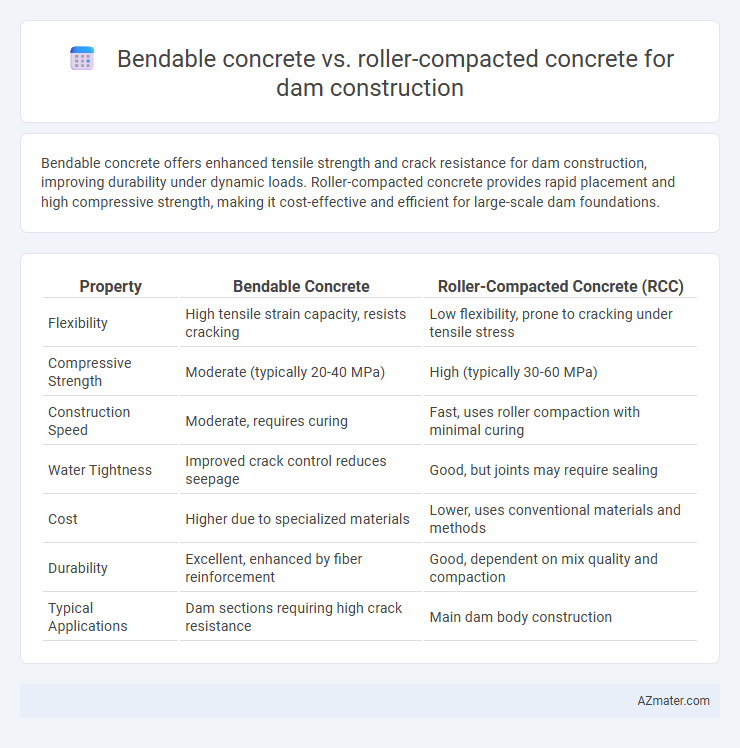Bendable concrete offers enhanced tensile strength and crack resistance for dam construction, improving durability under dynamic loads. Roller-compacted concrete provides rapid placement and high compressive strength, making it cost-effective and efficient for large-scale dam foundations.
Table of Comparison
| Property | Bendable Concrete | Roller-Compacted Concrete (RCC) |
|---|---|---|
| Flexibility | High tensile strain capacity, resists cracking | Low flexibility, prone to cracking under tensile stress |
| Compressive Strength | Moderate (typically 20-40 MPa) | High (typically 30-60 MPa) |
| Construction Speed | Moderate, requires curing | Fast, uses roller compaction with minimal curing |
| Water Tightness | Improved crack control reduces seepage | Good, but joints may require sealing |
| Cost | Higher due to specialized materials | Lower, uses conventional materials and methods |
| Durability | Excellent, enhanced by fiber reinforcement | Good, dependent on mix quality and compaction |
| Typical Applications | Dam sections requiring high crack resistance | Main dam body construction |
Introduction to Dam Construction Materials
Bendable concrete exhibits high tensile strain capacity and crack control, making it suitable for dam construction areas prone to seismic activity and cracking. Roller-compacted concrete (RCC) offers rapid placement and cost efficiency, favored for large-scale dam projects requiring structural mass and durability. Selection between bendable concrete and RCC depends on the dam's design load requirements, environmental conditions, and maintenance expectations.
Overview of Bendable Concrete
Bendable concrete offers enhanced tensile strength and flexibility compared to traditional roller-compacted concrete, making it highly effective in dam construction where crack resistance is critical. This innovative material incorporates engineered fibers that improve durability and reduce maintenance costs over time. Its ability to accommodate structural movements without compromising integrity provides significant advantages for long-term dam performance.
Overview of Roller-compacted Concrete
Roller-compacted concrete (RCC) is a high-density, low-slump concrete designed for rapid placement using asphalt paving equipment, offering enhanced construction speed and cost efficiency in dam projects. RCC's composition includes a lower cement content and reduced water-to-cement ratio compared to traditional concrete, resulting in improved durability and reduced permeability essential for dam stability. Its compacted nature and layering technique provide superior shear resistance and structural integrity, making RCC a preferred choice for large-scale dam construction over bendable concrete in many cases.
Key Material Properties Comparison
Bendable concrete exhibits high tensile strength and enhanced ductility with fiber reinforcement, making it suitable for absorbing stresses and reducing crack propagation in dam construction. Roller-compacted concrete (RCC) offers superior compressive strength and rapid placement capabilities, ideal for large-scale dam foundations requiring quick setting and load-bearing capacity. While bendable concrete excels in flexibility and crack resistance, RCC provides robust durability and cost-effective construction efficiency for dam structural integrity.
Structural Performance in Dam Applications
Bendable concrete exhibits superior crack resistance and enhanced tensile strain capacity, making it highly effective in dam applications prone to dynamic loads and temperature fluctuations. Roller-compacted concrete (RCC) provides high compressive strength and rapid construction benefits but is more susceptible to brittle failure under tensile stresses common in dam structures. The choice between bendable concrete and RCC significantly impacts dam durability, with bendable concrete offering improved structural resilience against crack propagation and deformation.
Durability and Crack Resistance
Bendable concrete offers superior crack resistance compared to roller-compacted concrete (RCC) due to its enhanced tensile strain capacity, reducing the likelihood of structural fissures under dynamic loading in dam construction. RCC demonstrates excellent compressive strength and rapid placement benefits but tends to be more susceptible to shrinkage cracks, which can compromise long-term durability in water-retaining structures. The improved durability of bendable concrete, characterized by its fiber-reinforced matrix, significantly enhances the service life and reduces maintenance needs in dam infrastructures.
Installation and Construction Techniques
Bendable concrete offers enhanced flexibility and crack resistance, allowing for easier placement and reduced need for traditional joints during dam construction, which minimizes maintenance and extends structural durability. Roller-compacted concrete (RCC) utilizes a dry mix placed with heavy rollers, enabling rapid construction with high compaction and reduced curing time, making it ideal for large-scale dam projects requiring efficient installation. Both materials demand specialized equipment; bendable concrete requires careful mixing to maintain fiber distribution, while RCC relies on precise layer thickness and compaction techniques to ensure stability and strength.
Cost Analysis and Economic Considerations
Bendable concrete offers enhanced crack resistance and durability, reducing long-term maintenance costs in dam construction compared to roller-compacted concrete (RCC), which typically has lower initial material and placement expenses but may require more frequent repairs. RCC's rapid placement rate minimizes labor and formwork costs, making it economically favorable for large-scale projects with tight timelines. Evaluating lifecycle costs, including material, labor, and maintenance expenditures, is crucial for determining the most cost-effective choice between bendable concrete and RCC in dam engineering.
Environmental Impact and Sustainability
Bendable concrete, known for its high ductility and crack resistance, reduces maintenance needs and extends dam lifespan, thereby minimizing environmental disruption over time. Roller-compacted concrete (RCC) offers rapid placement and lower cement content per cubic meter, which decreases carbon emissions during construction. Both materials promote sustainability by enhancing durability and optimizing resource use, with bendable concrete favoring long-term resilience and RCC enabling efficient, low-impact construction processes.
Suitability Recommendations for Dam Projects
Bendable concrete offers enhanced flexibility and crack resistance, making it suitable for dam projects in seismic zones or areas prone to thermal expansion stresses. Roller-compacted concrete (RCC) is preferred for large-scale dam constructions due to its rapid placement, cost-effectiveness, and high durability under heavy load conditions. Projects requiring fast construction timelines and substantial structural stability typically recommend RCC, whereas bendable concrete is ideal for structures demanding improved longevity through superior crack control.

Infographic: Bendable concrete vs Roller-compacted concrete for Dam construction
 azmater.com
azmater.com